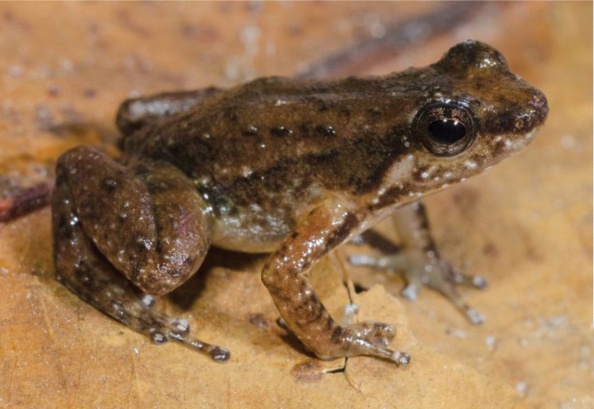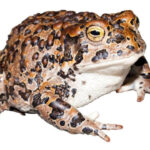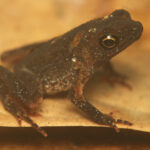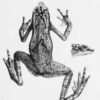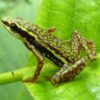Anomaloglossus apiau: Unveiling the Secrets of a Rare Amazonian Gem#
Deep within the shaded understory of the northern Brazilian Amazon, lives a humble and enigmatic species of frog, the Anomaloglossus apiau. Small, discreet, yet incredibly fascinating, this amphibian quietly survives beneath the lush foliage, revealing itself only to those fortunate enough to venture off the beaten path. With a name derived from the specific locality it inhabits—the unique Apiaú region—this small frog holds considerable intrigue and ecological significance, often overlooked by casual nature enthusiasts.
Despite its modest appearance and elusive behavior, Anomaloglossus apiau plays an intriguing role within its hidden niche, creating connections within the complex tapestry of Amazonian biodiversity. Scientists consider its presence indicative of a healthy ecosystem, tying this diminutive yet intriguing species deeply to the integrity and biodiversity of its rainforest territory.
One fascinating aspect of Anomaloglossus apiau is its cryptic lifestyle. Unlike the famously vibrant poison dart frogs often synonymous with the Amazon, this species remains well-camouflaged and subtly colored, stimulating curiosity and admiration for wildlife enthusiasts who seek to better understand nature’s hidden corners.
Taxonomy and Classification#
Anomaloglossus apiau belongs to the amphibian class Amphibia, order Anura, family Aromobatidae, and genus Anomaloglossus. Within the Aromobatidae, genus Anomaloglossus encompasses various small, terrestrial frogs—often characterized by subtle coloration patterns and fascinating breeding behaviors.
First described scientifically in 2015 by prominent herpetologists Fouquet, Souza, Nunes, Kok, Curcio, Carvalho, Grant & Rodrigues, Anomaloglossus apiau is a relatively newly-discovered species, highlighting just how much there is still to learn about Amazonian diversity.
The classification of Anomaloglossus apiau has helped scientists unravel evolutionary relationships within the Aromobatidae family, shedding new light on rainforest frog diversity. Closely related species such as Anomaloglossus stepheni help researchers highlight subtle distinctions and shared characteristics unique to each habitat.
Natural Habitat#
An Amazonian Refuge#
This particular frog has so far only been recorded in one specific region—the Apiaú locality, nestled within Roraima state in northern Brazil. The Apiaú region exhibits a mosaic of dense lowland rainforest interwoven with meandering streams, dense leaf litter, and luxuriant vegetation. Here, among the damp leafy ground cover and richly diverse fungal and insect communities, Anomaloglossus apiau finds its perfect microhabitat.
Because of this specialized habitat, these frogs rely intensely upon ecosystem stability and moisture availability. They thrive in shaded, humid, and relatively undisturbed forest floors, emphasizing the need for intact and healthy rainforests.
Habitat Microcosm#
These frogs are terrestrial dwellers. They utilize the leaf litter and damp soil as sanctuaries from predators, heat, and dehydration. Their lifestyle mirrors the rhythms and cycles of an increasingly fragile ecosystem.
Throughout the day, humidity remains reliably high beneath dense canopy cover. The richness of leaf litter offers protection, camouflage, and abundant prey. Leaf litter insects, spiders, and other small invertebrates form the foundation of their diet. Frogs such as Anomaloglossus apiau regularly demonstrate the interconnectedness between land insects and amphibian populations, showcasing the delicacy and interdependence inherent in these ecosystems.
Physical Characteristics#
From Camouflage to Survival#
At first glance, the Anomaloglossus apiau does not command immediate attention like its vividly colored counterparts in other parts of the Amazon. Rather, its understated appearance ensures its survival, enabling effective camouflage. Adults rarely exceed 20 millimeters (approximately 0.8 inches), making them remarkably small even within their family.
The frog’s dorsal coloring includes shades of brown, olive, or gray, merging seamlessly with the surrounding leaf litter. Its skin texture is relatively smooth, subtly granular, allowing it to blend perfectly among fallen leaves, moss, and soil particles. Notably, the coloration and markings aid predatory avoidance, offering an evolutionary advantage in an environment teeming with hungry epigeal animals.
A closer examination of this petite frog often reveals fine patterns—intricate speckles, stripes, or subtle blotches across its body. These nuanced markings, while advantageous in camouflage, also help scientists identify individual frogs and study the complexities of their social and territorial behaviors.
Behavior and Life Cycle#
Feeding Habits: Small Hunters Among Leaf Layers#
Predominantly insectivorous, the Anomaloglossus apiau silently hunts the leaf-litter forest floor in search of small insects and arthropods. Equipped with sharp senses, it quickly detects subtle movements of prey items such as ants, beetles, tiny spiders, and small flies. The frog’s tongue flicks forth in microseconds, snapping up prey with remarkable efficiency and precision.
Mating Rituals: Captivating Calls and Subtle Romance#
Like many Amazonian frogs, breeding tends to coincide with periods of heavy rain, when humidity levels peak. Males emit delicate yet easily distinguished calls from their leaf-litter shelters—soft chirps, clicks, or faint trillings designed carefully both to attract females and discourage male rivals.
Breeding pairs lay eggs amid moisture-rich soils and leaf debris. The parental investment observed in this genus tends to be notably high. Unlike many amphibians that abandon eggs shortly after deposition, Aromobatidae frogs often demonstrate some degree of parental care. Though specific details about Anomaloglossus apiau reproduction are still under active research, it is plausible they share similar nurturing behaviors.
A Vulnerable Amphibian Childhood#
After hatching, tadpole stages occur in stretches of shallow streams, slow pools, or damp leaf-litter depressions filled with water. Numerous predators threaten these fragile stages, ensuring only the hardiest tadpoles reach adulthood. This vulnerability underscores the many challenges species like Anomaloglossus apiau face to maintain viable populations amid complex rainforest food webs.
Ecological Role#
Despite its tiny scale, the ecological role this frog species plays is disproportionately large. Acting as both predator and prey, Anomaloglossus apiau functions as a vital player in balancing insect populations that influence broader forest health. Further, this frog feeds larger predators in the rainforest hierarchy—birds, larger amphibians, reptiles, and small mammals all depend partly on these frogs as protein sources.
As an indicator species sensitive to environmental degradation, their abundance and health signal overall ecosystem health, thus providing environmental researchers essential data regarding habitat stability, climatic shifts, and broader ecological disturbances.
Threats and Conservation Status#
Currently, the limited geographic range of Anomaloglossus apiau renders this species particularly vulnerable. Primary threats include habitat alteration, deforestation, climate change, and introduction of invasive species. Deforestation, driven primarily by agriculture expansion and infrastructure development, remains the most significant existential threat for regional amphibians.
Although not yet formally assessed by the International Union for Conservation of Nature (IUCN), its restricted habitat prompts infectious diseases, climate fluctuations, or habitat destruction to pose outsized threats to population stability. Conservation initiatives that preserve or restore habitats and strengthen protective measures represent the best hope for this rare amphibian.
Cultural and Scientific Significance#
Although traditional significance specific to this species remains limited thanks to its relatively recent scientific discovery, the broader Amazonian frogs often symbolize environmental purity among indigenous peoples. Scientifically, understanding newly described species like Anomaloglossus apiau provides immense insight into biodiversity conservation, evolutionary ecology, and even valuable medical discoveries through amphibian toxins.
Conclusion#
Though few have glimpsed Anomaloglossus apiau, its unobtrusive life speaks volumes of the necessity to value and protect small hidden treasures of our planet’s forests. Encouraging further research, raising public awareness, and promoting habitat conservation remain essential to preserving this species—and indeed, the vibrant web of life inherent in the Amazon itself.
Through understanding and stewardship, we ensure not only the survival of a hidden frog but the thriving well-being and balance of one of Earth’s richest ecosystems.




